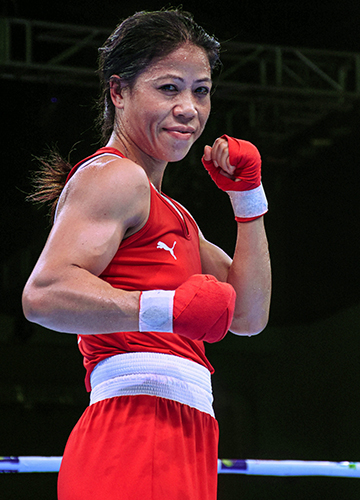The Ryogoku Kokugikan in Tokyo is the spiritual home of sumo wrestling, national sport of the 2020 Olympics host country. It has hosted every legendary national sumo fight since it was rebuilt in 1985. Few stadia in Japan are as iconic as the kokugikan (translates to ‘stadium of national sport’), despite its capacity of just 11,000 people.
At the 2020 Olympics, boxing is the only sport that will be hosted at the kokugikan. But the significance of the arena might be lost on the pugilists. Vijender Singh, India’s first Olympic boxing medallist, told THE WEEK that he does not care for venues. “I never remember the city name, place name…. It’s all about boxing. Go into the ring, beat that guy, come out with the medal,” he said.
Perhaps it sums up a boxer’s mentality. A single-minded focus to win that shuts off everything else around them. In that moment, everything outside the 6.1sqm ring fades to black. Andre Agassi in his book, Open, said that only boxers could understand the loneliness that tennis players experience on court. For those 11-minute-long bout, they undergo a lifetime of training and struggle. And struggle really is the thread that runs through the current Indian contingent.
An unprecedented nine boxers will represent India across the 13 categories, and each of them has had to make incredible sacrifices enroute to Tokyo. Vikas Krishan (69kg) has been on the road for so long, he could only see his two babies “grow up in photographs” over the last year; Ashish Kumar (75kg) qualified for Tokyo just a month after his father’s demise; Simranjit Kaur (60kg) lost her father in 2018—four months before her first world championship medal—making her the sole breadwinner of her family; Lovlina Borgohain (69kg) missed precious training time in February this year to be with her mother during her kidney transplant; several of the boxers contracted Covid, too.
And yet, the expectations have never been higher for India. The team is spearheaded by 2012 bronze medallist and six-time world champion Mary Kom, and world No 1 Amit Panghal, top seed in his 52kg category. Panghal is India’s best hope for a gold this time.
Among the men, Krishan is the most experienced, and this is his third Olympics. He lost out on a medal in Rio after a quarterfinal loss. “What I learnt from those past mistakes is mainly discipline—train on time, sleep on time, take nutrition on time,” said Krishan, who is managed by JSW Sports. “The expectation and reality are not very different for me. I am expecting a gold medal and I am going to get that.”
Krishan says the men’s team is one of India’s all-time best. He is the only Indian male boxer to win gold medals at both the Asian and Commonwealth Games. Of the others, Panghal and Manish Kaushik (63kg) have won medals at the world championships, Asian Games and CWG and Ashish Kumar has won silver at the Asian championships. Satish Kumar is the first Indian to qualify in the super heavyweight category.
Since the arrival of high-performance director Santiago Nieva in 2017, the boxers have been regularly given detailed analysis of their bouts, technique and opponents, which has transformed their approach to matches. He builds personalised strategies for them using video analysis, sending them clips on WhatsApp of the tweaks he wants them to make.
The Asian championships held in May in the UAE was a fruitful outing for the women. Pooja Rani (75kg) won gold, Mary Kom (51kg) won silver, and Kaur and Borgohain won bronzes. “We missed out on few weeks of training before the Asian championships because of the second wave, but that tournament was very important for us as we wanted to check our progress and rectify our mistakes,” said Raffaele Bergamasco, foreign coach of the women’s team. “Post that, we have continuously worked on the technical and strategic part with high intensity, but above all on leg work, which is very important.”
Also read
- Spotlight is firmly on the women at Tokyo Olympics
- Tokyo 2020: India aims to match or better London 2012
- With 4 seeded wrestlers in squad, it would be surprising if India draws blank in Tokyo
- Neeraj Chopra could script a new chapter in Indian athletics
- Tokyo 2020: Dutee Chand focused on realistic target
Mary Kom might be 38, but has accepted the fact that she is no longer the fastest mover in the ring, and has instead added muscle, shifting focus from speed to power. “Mary is relentlessly focused and works very hard, and that is why she can still make a difference today,” said Bergamasco. “Having her in the group is a constant source of motivation for everyone in the team.”
Rani, meanwhile, has not had it easy either. She has had to defy her father’s resistance and a career-threatening injury to win two Asian championship gold medals before finally making it to Tokyo at age 30. Like Krishan, Kaushik and many others, she comes from Bhiwani, aka India’s ‘mini-Cuba’ with its boxing culture.
Ever since Vijender set the ball rolling for a sport that India rarely excelled at before, boxing has witnessed a spike in interest in the country, resulting in a rise in investment and better infrastructure that have all culminated in this record-size contingent, despite the corruption and in-fighting that plagued the national body in the early 2010s. With all that this contingent—and the sport in India—has been through, a challenge of epic proportions lies ahead. The kokugikan, and history, beckons.



